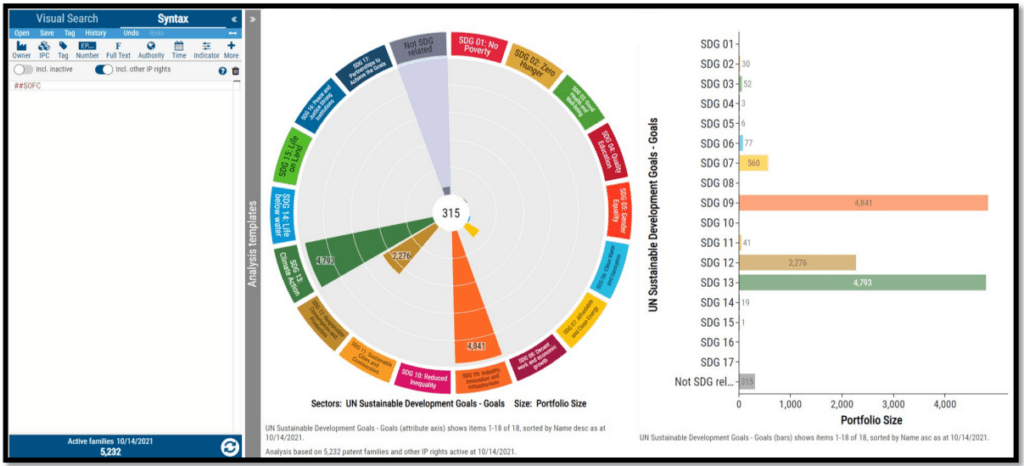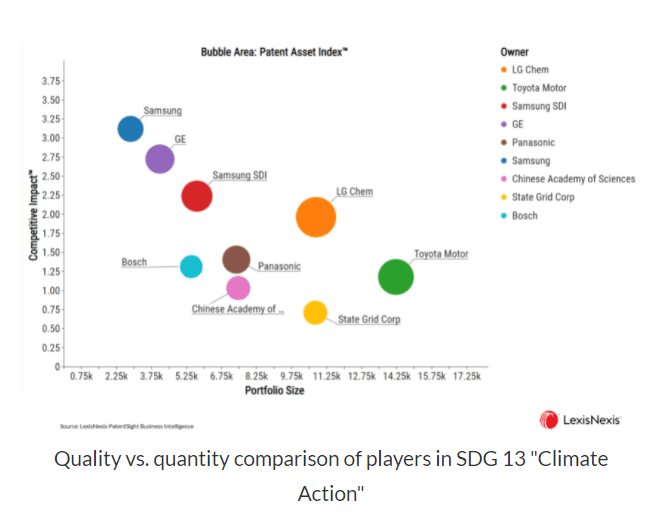5 Advantages of Mapping Patents to the UN Sustainable Development Goals

While there are obvious benefits to tracking and measuring sustainable innovation—like bringing more transparency to one of our world’s most pressing topics—what other advantages does mapping patents to the UN Sustainable Development Goals bring to businesses? From identifying opportunities and gaps in sustainable technology to monitoring progress towards a more sustainable patent portfolio, here are 5 advantages of leveraging this unprecedented analysis, all of which can help strengthen stakeholder engagement, shareholder funding, and employee retention by proving sustainable efforts with objective data.
1. Performance measurement and control
The United Nations developed a framework for the 2030 Agenda for Sustainable Development that is built around the definition of sustainability that is “meeting the needs of the present without compromising the ability of future generations to meet their own needs.” The Agenda is a plan for action and outlines 17 United Nations Sustainable Development Goals (UN SDGs).
Under each of the 17 UN Sustainable Development Goals, there are targets that, when reached, will lead to the achievement of the goal. These are global in nature and are universally applicable and complemented by indicators at the regional and national levels (developed by Member States). They can be mapped to advancements in science and technology as expressed through patentable inventions. The detailed framework is maintained by the UN Statistics Division and is documented in the SDG Indicator Database, which includes a repository of metadata.
In Creating a Strategy for a Better World PricewaterhouseCoopers surveyed over 1,100 companies who reported:

While there are obvious benefits to tracking and measuring sustainable innovation—like bringing more transparency to one of our world’s most pressing topics—what other advantages does mapping patents to the UN Sustainable Development Goals bring to businesses? From identifying opportunities and gaps in sustainable technology to monitoring progress towards a more sustainable patent portfolio, here are 5 advantages of leveraging this unprecedented analysis, all of which can help strengthen stakeholder engagement, shareholder funding, and employee retention by proving sustainable efforts with objective data.
2. Identification of technologies that match UN Sustainable Development Goals targets and indicators
By mapping advancements in science and technology as expressed through patentable innovation against the UN Sustainable Development Goals, users gain access to insight on sustainable innovation in distinct fields across the globe. This unique proposition enables patent and non-patent experts to easily access their field of interest and gain valuable information. This can lead to better decision making and reporting on sustainability topics and can inform Research and Development (R&D), support investment strategies, enable effective evaluation, or support corporate communication to educate employees, customers and shareholders. With the global sustainability drive in full force, there are already millions of data points to analyze—and some intriguing results to be found. With the new UN Sustainable Development Goals mapping, featured in the LexisNexis® PatentSight® solution, the SDG goals that are leading the way on sustainable patents can be identified. New Emerging Technologies Example: Solid Oxide Fuel Cells (SOFC):

3. Identification of risks and opportunities of sustainable technological development
According to the Harvard Business Review Comprehensive Business Case for Sustainability “investing in sustainability is not only a risk management tool; it can also drive innovation. Redesigning products to meet environmental standards or social needs offers new business opportunities.” The mapping of patents to the UN SDGs, in combination with the industry-proven and validated patent value indicator PatentSight Patent Asset Index™, reveals real champions and allows stakeholders and shareholders a better decision-making and reporting process. The objective mapping of the global patent system to the UN SDGs allows for:
- Identification of growth opportunities in emerging markets
- Competitive advantages in future-oriented technologies
- Support of strategic decision making for sustainable investment
- Understanding involvement and identify gaps in sustainable technology development
- Tracking progress of investments in sustainable R&D and technology over time
- Learning which sustainable technologies make an impact and which are less relevant
4. Portfolio management and competitive landscape analyses
To develop a strategy for sustainable technology investment,an organization needs to understand their own portfolio, get an overview of the competitive landscape and identify trends, gaps and whitespaces. Being able to determine a patent portfolio’s competitive strengths and weaknesses is key to understanding what strategies or actions will be necessary to meet the goals and stay ahead of the competition. This includes:
- Identifying competitive strengths and weaknesses
- Increasing portfolio efficiencies
- Defining country filing strategies
- Managing annuity costs
- Uncovering pruning potential and cost-saving opportunities
See which companies are investing in sustainable technology and the strength of their portfolios related to the UN Sustainable Development Goals as measured by the Patent Asset Index on UN SDG 13.

5. Identification of collaboration partners, M&A targets, and new entrants in UN Sustainable Development Goals related technologies
Sustainability efforts can be supported and accelerated through partnerships and licensing. PatentSight can provide details on the patent portfolios of the players in a specific technology. This allows for evaluation of a portfolio and identification of individual patents that may be most attractive for licensing. Potential licensing targets can then be profiled to gain deeper insights.
- Specifically, PatentSight analytics can be used to:Study acquisition targets’ patent portfolios
- Analyze innovation landscapes and technological fit
- Find key patents within portfolios
- Determine critical issues like average ages, remaining lifetimes or legal status
Mapping patents to the UN Sustainable Development Goals allows businesses to objectively measure progress, understand their portfolio as well as their competitor’s, find licensing and M&A targets and analyze risks and opportunities within the Sustainable Development framework. Essentially, with a strong SDG portfolio, the analyses results can be used to strengthen the position, internally and externally. With a weak SDG portfolio and ambitions to improve, goals and Key Performance Indicators can be implemented to measure progress.
Watch the On-Demand Webinar Calling for Action: How to Track and Measure Sustainable Innovation and Investments to learn how you can gain an unparalleled view into the global innovation landscape and empower decision-making for opportunities in sustainable technology.
Read When IP Meets Sustainability: Mapping Patents to the United Nations Sustainable Development Goals and SDGs vs ESGs: What is the Better Measure of Sustainability? to learn more.
*There are four SDGs not directly connected to technology and thus cannot be associated with patents.

Unveiling the Top Contributors to Global Sustainability Agenda 2030
Patents unlock the secrets of sustainable innovation! Discover the SDGs that have the strongest patent portfolios working towards achieving them. Find out which countries are developing competitive portfolios in this space with the most robust technologies in sustainable technology in our latest IP analytics report.

Want insights into how sustainably focused you and your competitors are?
Conduct objective patent analyses against the United Nations Sustainable Development Goals (UN SDGs) using LexisNexis® PatentSight®.
